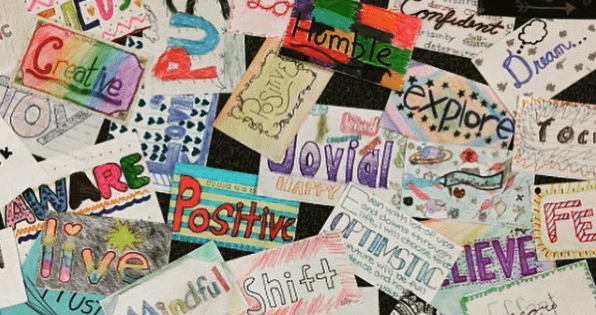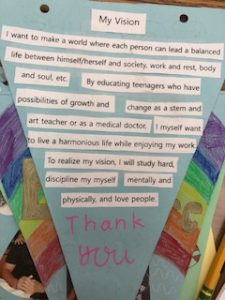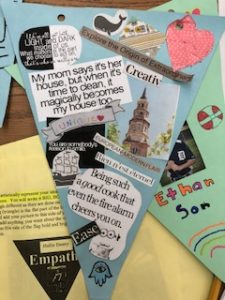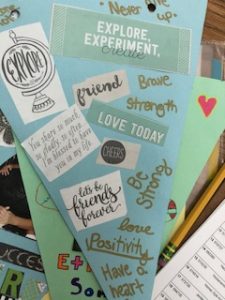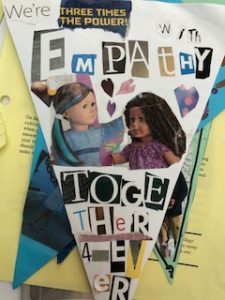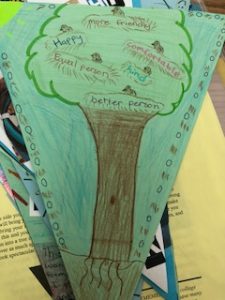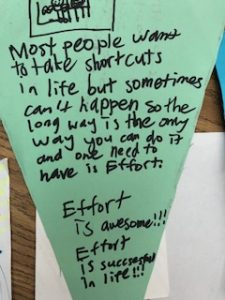My Mornings Before Mindfulness
Wake up, slam the alarm and roll out of bed. Scream out to my children to wake up, begin my bathroom routine. I’m feeling grumpy, but I’m not sure why. Start coffee, but I realize I am out of to-go cups. Mumble a few bad words. Realize I need to run to Starbucks on my way to school, so begin to more emphatically direct my kids to get up and get going! As I am ready to go out the door I am in full panic mode – heart racing, disheveled, and overwhelmed. I am now late with no time to get coffee, had to throw lunches together, and already argued with and felt annoyed at my children.
When I get to school, I rush to let my students in the door. I say hello to those who address me, but I am way too focused on getting to my computer to notice anyone else. Although totally unaware of this, students sense this anxiety and seem to be accustomed to tiptoeing around teachers in bad moods. They sit down and stay out of my way. The bell rings…
In the days before mindfulness I was a puppet of my emotions. I truly had no idea why some days some things bothered me more than they did on others. I did not understand that I had a choice in how I respond. I lived in a highly reactive world. Sometimes it worked for me because as teachers we need to think quickly and constantly manage a million things simultaneously, and sometimes it created days that felt like I was on a hamster wheel.
Just writing this now, I can feel that my chest is heavy, as the stress of that time is far too familiar. I lived so much of my life feeling like I was on a rollercoaster. I longed for a future that was easier. I constantly focused on things I could not change and had no idea how to deal with all of life’s challenges with so much going on at the same time. Then I found mindfulness, and slowly things started to change. I found a tool for my brain that would change my life personally and professionally forever.
Discovering Mindfulness
It was my 20th year of teaching middle school social studies in the Palos Verdes Unified School District when I first heard about mindfulness. I was talking to my friend from college who was now a teacher in Palo Alto about what their district was doing in response to the horrifying fact that Palo Alto now had a teen suicide rate four to five times higher than the national average. She told me that the Palo Alto district was training teachers in mindfulness. I had no idea what this entailed but was instantly interested in a tool for teachers to better support the emotional aspects of being an adolescent in a high stakes district.
I took the 101: Mindfulness Foundations class with Mindful Schools. For the first time in my life I began to understand why I was the way I was. Why my moods fluctuate. Why my thoughts were so strongly attached to my reactions. I was blown away by the simplicity of mindfulness as a tool for my brain. I began to feel a connection to all of humanity, notice my thoughts, and discover how critical and belittling they were. The voice inside my head was a horrible, relentless critic. I began to ever so slowly notice my emotional and physical response to those thoughts and to things that happened around me. I found out there was a choice in how I responded, yet I still didn’t know how to stop reacting in the middle of one of my triggers.
I learned to breathe, sit in stillness, and notice the thoughts as if they were guests but for the first time realizing they all did not have to move in. It was an eye opening, radical shift in the way I saw myself, my world, and of course my classroom. It was my first step in a journey, an adventure that would change my life forever. I signed up to learn mindfulness as a tool for my students, but I learned early on that teaching mindfulness starts first with being a more mindful human. It is literally the cliché that you need to practice what you preach! I began to learn and explore mindfulness as both a practice for myself and a tool that benefitted my students.
Bringing Mindfulness to My Classroom
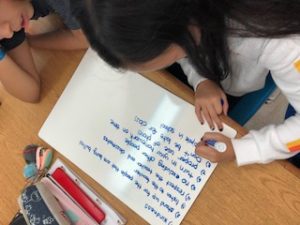
We took mindful breaths as a class before tests and suddenly parent and student feedback showed that, not only were students participating in mindful sits and utilizing mindful tools in the classroom, they were actually bringing their new knowledge home.
The vibrant energy and joy that mindfulness brought to my teaching and to my life was like nothing I had ever experienced before. It was my 20th year of teaching, and I felt wide-eyed and bushy tailed in my attitude towards the students. I noticed a huge change in the way I approached and supported students. I began to see how my moods affected their nervous systems.
Becoming Attuned to Students
I have always loved teaching and considered myself to be student-centered. Yet, in reflection, it was easy to connect with students who sought my validation and attention. But it was the other students, the introverts, the ones who didn’t reach out, who still evaded me.
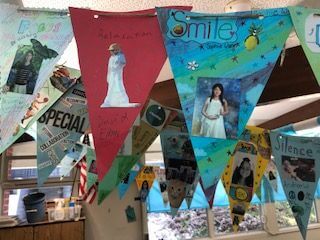
The next day, she brought it proudly to school. Later that day as we rode home from school I asked her about the poster and how it had been received my her teacher.
Hallie: (shrugging her shoulders) “I got an A.”
Me: “And… Did she love it?”
Hallie: (blandly) “I don’t know, she didn’t say anything.”
When we got home Hallie tossed the poster in the trash can. Then it hit me. How many posters had I missed? How many times had a student stayed up all night going way above the expectations, and I didn’t even notice? How many times was I not attuned to my students needs? How many times was I too busy with the next task or thought to be present to notice a child’s individual efforts for connections?
My heart sank. Not just for Hallie, but for all the students that I had missed attuning to. My intentions changed. I wanted to see my students. We all want to be seen. We all became teachers to connect with students. These connections are only possible when we are present. Mindfulness taught me that attunement and connections are fundamental to running a classroom.
I slowly started to become more comfortable with being uncomfortable. I practiced sitting with those big emotions, and this is something I will surely be working on until I retire. I am noticing my thoughts, I am noticing my body, I am noticing my students and their individual needs.
Infusing Mindfulness into Everything
This year everything I had been learning about mindfulness came together in one invigorating and profound shift. After completing the Mindful Teacher Certification Program, I realized that every day is a lesson in mindfulness (not just Wednesdays).
I am encouraging students to shift, pause, and notice their thoughts and emotional responses. I invite students to think about possibilities and encourage them to take risks in thinking metaphorically or analytically. I remind them of the fears we have when we take risks, and I am helping students notice their emotional responses to learning. May it be a map or a section of reading, I encourage students to not only notice their resistance or excitement but ask them to speculate what people of the past may have thought about or felt in these situations or locations.
Speaking and listening have always been vital tools in any classroom. Teaching mindful, intentional speaking and listening has transformed how I teach and how students utilize these skills. We talk about listening through nonverbal, supportive cues. Listening to support vs. listening to give feedback. We talk about being naturally more introverted and the need to focus on speaking out. We discuss the need for extroverts to focus on listening. We have conversations in class about how collaborative and discussion skills are not just for the classroom but for life. We talk about the feelings we notice when we feel truly heard and the importance of making other people feel heard in important conversations.
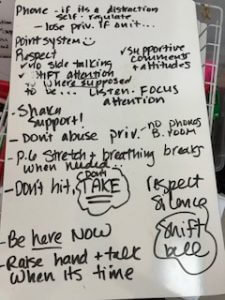
My classroom management has changed from teacher dictator to coach facilitator. My own mood about student behavior gets lighter and lighter through the years. I no longer take everything a child does personally. When I notice myself going back to those ways, I stop pause, reflect and re-route.
How My Mornings Are Today
Now, a few years later, my morning routine is still hurried but much more joyful. I make an intention to look for joy in the morning. I don’t get caught up in the should, and I am much more positive as I leave for work. There are days that I am still anxious, but these days are far and few in between. By the time I get to work and start my day, I have stopped to sit mindfully and worked on letting it go before it creeps into my entire day. My own practice is just that – a practice. I intend to sit 20 minutes a day. But on some days I sit 5 minutes and that’s ok too.
I get curious about areas where I am still triggered. Currently, I am struggling with my daughter’s persistence in taking over my music with her playlists the second she jumps in the car. I notice my body clench up and contract. I notice my mind racing with thoughts of control. I notice my need to tell her how much I do for her. I am working towards letting this go because when I ask myself the question, “Is this important?” The answer is always, absolutely not.
I notice that on the days I sit mindfully, I am better able to follow through my intentions to find radical joy in all I am doing. I arrive at school looking for joy. On the days I walk mindfully through the halls, I notice I am happier by time I arrive at the office to check my inbox. I make eye contact with my students and always greet them with a good morning. I invite them to sit mindfully before class on as many days as we can fit it in. I notice the need for connections in teachers, in parents, and more importantly in my students.
Mindfulness is about being present, mindfulness is about noticing where I am getting triggered and doing the work to loosen that up in my life. Mindfulness is, as always, a practice.
Nicole Kraake has been a teacher for 23 years and bringing mindfulness to her students on a weekly basis has transformed her classroom. She lives in Palos Verdes Estates, CA. In addition to being a teacher, she is a mom to 4 kids and loves all thing mindfulness, the beach, and hiking. Nicole completed the Mindful Schools Mindful Teacher Certification Program, Class of 2018.

